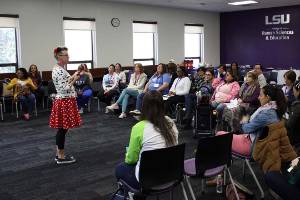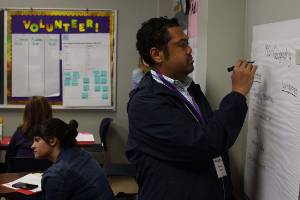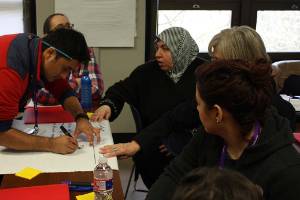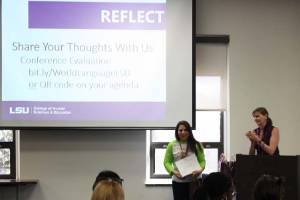June 2020
World Language Teaching Online: A New Reality
June 2, 2020

On March 7, 2020, the LSU School of Education held its second annual World Language Teaching Practices and Techniques. This conference brought together more than 90 World Language, ESL, and Immersion teachers and session presenters from across the state to learn new techniques to support our students on the path of language acquisition. The excitement of so many dedicated teachers ready to learn and gain insight into new ways to enrich their students’ classroom language experiences was a joy to see. The nation has begun to recognize the importance of knowing more than one language, and we must equip our students need with multiple language skills to be successful in a global society.
The nation has begun to recognize the importance of knowing more than one language, and we must equip our students need with multiple language skills to be successful in a global society.
The focus of this conference is to provide teachers with specific innovative teaching techniques and practices that they can immediately apply to their classroom. This year, we were fortunate not only to have Annabelle Allen (La Maestra Loca) to present the concept of Comprehensible Input (CI) as well as specific strategies on how to use it in the classroom but also Viviana Tracy, who presented a demonstration using CI with her Spanish Middle School students. This live demonstration allowed teachers to have a clear idea of the technique and its application. Furthermore, the attendees were so impressed to see that her students were willing and eager to take time out of their Saturday to demonstrate their Spanish fluency and explain why they enjoy and advance using CI.
Dr. Jamie Hipp’s session on Using the Arts to Build Language and Literacy was a huge success as so many teachers were eager to learn how to incorporate the arts to promote language acquisition for all ages and proficiency levels. Teachers participated in creating the art forms of creative movement/dance, visual arts, music, and theatre while building language.
The SIOP Model and BeGLAD: Guided Language Acquisition Design sessions were presented by a group of Two-Way Immersion teachers (Laura Acosta, Araceli Guerrero, Tera Melacon, Elizabeth Mohan, Julia Lopez, Brittany Pierre, and Mari DeRouen) from the Lafayette School District. And, without the support of Dr. Haj Broussard, from the University of Louisiana at Lafayette (ULL), these two sessions would not have been possible. The SIOP and BeGLAD workshops provided teachers with the fundamentals of both approaches including practical teaching activities. In fact, professional development on how to use these methods is highly sought after and recognized as the gold standard in second language teaching.
Lastly, we were excited to have Michéle Braud and Alice Garcia from the Louisiana Department of Education. Ms. Braud presented the groundbreaking work from Project Sam to ACTFL’s standard
on how to design an Integrated Performance Assessment. While Ms. Garcia spotlighted
how the Louisiana’s new EL accountability measures impact instruction and discussed
ways to use formative assessments and other tools to measure EL growth inside and
outside the classroom.




Then, just a week later, the schools were closed across the state due to COVID-19, and we had to recreate our face-to-face learning environments to online ones. We were left scrambling, trying to learn new technologies to recreate online what took years to develop face-to-face. Furthermore, many wanted to begin applying the newly learned techniques and practices.
This is a new reality, and this article hopes to provide some guidance on the wealth of digital platforms available and which one will work best for your reality.
As we look forward to the fall, there are still many unknowns as to how classroom instruction will be delivered. Some teachers may already have a hybrid classroom where technology is already in place to enhance language acquisition; however, many teachers are still in a physical classroom. Fortunately, many national teacher associations, educators, and educational consultants have stepped up to deliver free resources that we can explore to optimize online learning if that happens to be our learning space in the coming year.
These resources and webinars can provide you with some tools and training to transform your classroom into an interactive and engaging online classroom. A brief description has been included for each of the resources and are valid for World Language, Immersion, and ESL teachers. In fact, most of the platforms, techniques, and approaches are applicable to all classrooms and content areas.
Creating an Online Learning Environment
In any language classroom, the objective is to have students use the target language meaningfully, interact in cooperative learning groups, and practice using academic language. Seidlitz Education is an educational consulting group that provides professional development for teachers of English Language Learners (ELLs). They have created free webinars specifically addressing the topic of creating online learning environments using both asynchronous and synchronous platforms. Dr. Stephen Fleenor discusses specific technologies and how to create these interactive learning groups. For many of us, we are accustomed to moving between small and whole collaborative groups but are not sure how to recreate this virtually. They also have webinars exploring distance learning for social studies and math in both digital and tech-free platforms for ELLs. In addition to the resources focusing on the content areas, Seidlitz includes information on how to support reading, writing, writing with sentence frames, and higher-order thinking skills.
Reimagining Reading
Providing comprehensible input through listening and reading is key to increasing students’ vocabulary and language acquisition. The American Council of the Teaching of Foreign Languages (ACTFL) has webinars on how to teach world languages remotely, create lessons using the standards, and apply specific tools and strategies for online teaching. They have some additional on demand professional development that address research-based teaching practices.
Carol Salva, Katie Toppel, and Tan Huynh put together a detailed webinar on how to create a virtual book study. This book study format can be modified for ESL, world language, and any content area instruction. I would also highly recommend following Carol Salva. She has a wealth of resources on her padlet website as well as her Boosting Achievement: The ESL Podcast where she discusses various topics concerning ESL and students.
Teaching World Languages: Holding True to the Standards in an Online Environment
The Ohio Department of Education has always maintained an excellent World Language Resource Center with a solid example of how to create an Integrated Performance Assessment, sample thematic units, instructional ideas and activities, assessments, and rubrics. Additionally, there is a detailed process using a Backwards Design when planning instruction for a thematic unit.
Continuing with their excellent support, they have responded to the needs of teachers having to transition to their classes to online. On their World Language Resource Center Page, there is an entire section on how to create lessons to include all modes of communication, styles of learning, and examples of choice boards. They also give an exhaustive list of digital platforms and how the to use them to craft interactive lessons and activities using the target language meaningfully. Finally, they include a number of resources for multiple languages, levels, and topics. You will find these resources beneficial for online and/or face-to-face instruction.
On the May 8th episode of Language Latte: A Podcast for World Language Teachers, Becky Morales discussed some of the most popular platforms and looked at their advantages and disadvantages. I would also recommend exploring her website for more resources at kisworldcitizen.org.
Stronger Together
I have heard this phrase since the beginning of the pandemic, and I believe that it is really true for everyone. After the conference, we received a lot of feedback saying how they really appreciated the opportunity to network with other teachers that are in similar situations and to learn from each other. Therefore, moving forward, I would like to share any resources that you have that may lend a hand in this time of need and encourage you to reach out to fellow colleagues. We not only need the support of these resources but also words of encouragement during these uncertain times.
No act of kindness, no matter how small, is ever wasted ~ Aesop
Additional Resources Worth Considering
- The TEFLology Podcast discusses language teaching and applied linguistics. They have just recorded two episodes on flipped classrooms and emergency remote teaching responses.
- We Teach Languages Podcast not only presents podcasts about language teaching but also considers the diverse perspectives of teachers.
- How COVID-19 Will Change ESL discusses the impact the epidemic will have on the ELL population. Be sure to watch other podcasts like: Teaching ESOL Online with Denise Maduli-Williams.
- The United States Department of Education and the Louisiana Department of Education have put out statements, resources, and best practices regarding ELs.
- From the English Learner Success Forum, they have provided a step-by-step action plan to use multilingual resources to support English learners’ remote learning. They have also included practices to consider when scaffolding for ELs in a remote environment.
- Larry Ferlazzo is an ESL teacher and author of nine books on ESL teaching. I highly recommend that you explore his website. Here, he has compiled his Best Resources, Articles, and Blogs for Teachers of ELLs.
- Teaching Tolerance’s mission statement is “to help teachers and schools educate children and youth to be active participants in a diverse democracy. They provide a number of classroom resources as well as specific resources on how to support students through coronavirus.
- EL Education grew out of a collaboration between the Harvard Graduate School of Education and Outward Bound USA to support teachers and students. There are pages of resources for teaching remotely and designing curriculum.
- News in Slow provides the news in five different languages.
Written by: Margaret Piccoli, PhD
Margaret W. Piccoli, PhD, is an adjunct professor at the School of Education. Dr. Piccoli received her undergraduate degree from Louisiana State University in Spanish and Foreign Language education. After graduation, she taught high school Spanish for five years while finishing her Master’s in Foreign Language Education. She then became an instructor at Ithaca College where she taught Italian. After moving to Italy in 2008, she began to teach English as a Second Language at the Università Cattolica in Piacenza to students seeking a dual degree in Italy and in affiliate universities abroad. After six years in Italy, she returned home to Baton Rouge where she completed the PhD program in Curriculum and Instruction at Louisiana State University. Her academic, teaching, and consulting interests lie in second language teaching methods, improvisation, and language learning through the theatre-arts.
